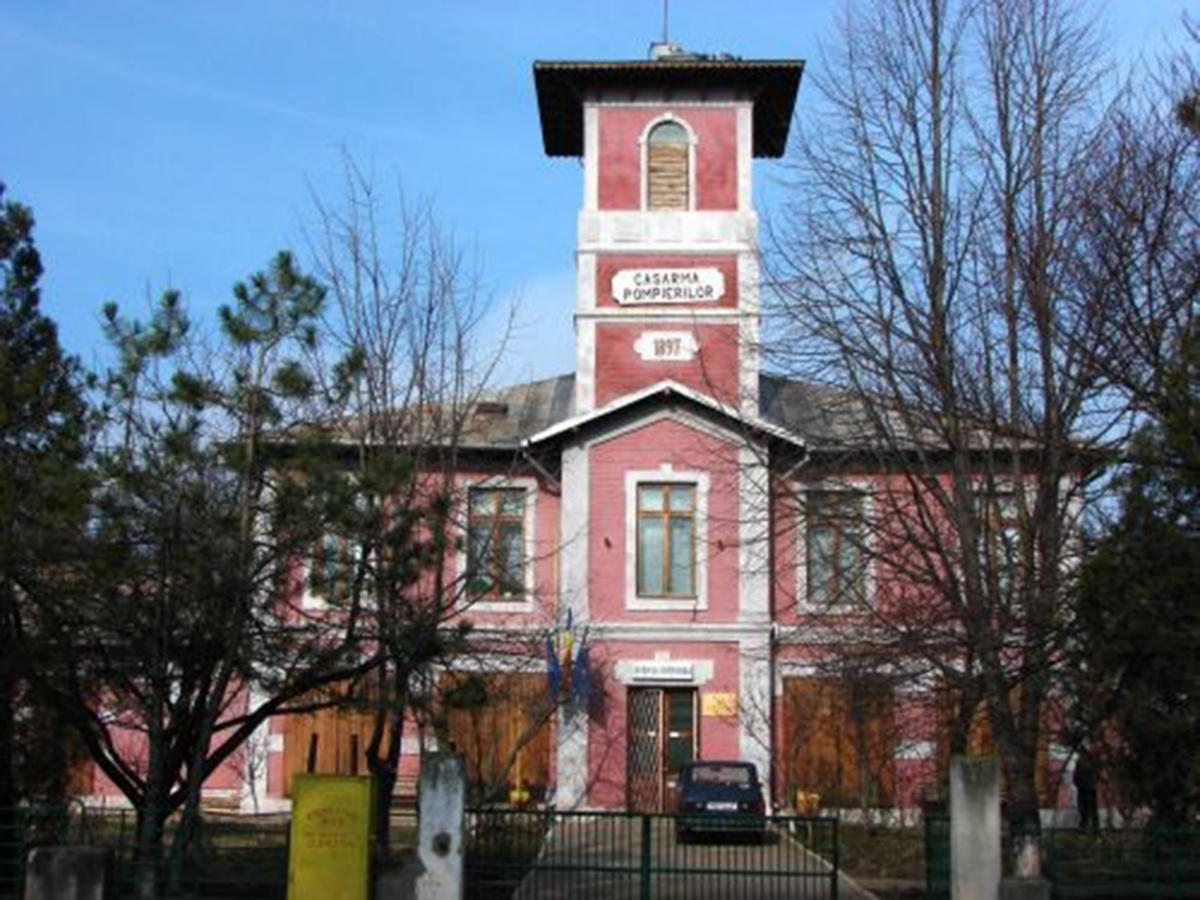The Firefighters Barracks
Category OtherLOCATION
Str. Pompierilor nr.1, Călărasi, Romania
DESCRIPTION
One of the buildings with which Calarasi is proud is the former Firefighers Barracks which nowadays has hosted the County Branch of the National Archives. Few know that this beautiful and imposing building was built only in three months. And this happened under the technical conditions of 1897.
The construction of the barracks was made thanks to the one million lei loan contacted by the municipality at the Central Savings Bank. The construction of the work entrusted to the entrepreneur Giuseppe Ciconi, which on 15 August 1897 began the work, and on November 15 the same year, the temporary reception of the site was made.
The work cost 48,000 lei, it was done according to the plans of the engineer of Ioan M. Neculcea, and it has long been the tallest building in the city (18 m).
HISTORY
The first measures aimed at preventing and extinguishing fires at Calarasi were the responsibility of the police. Thus, on October 2, 1843, the police of K. Nicolaidis asked the city commission to set up water wells, bulls, axes and two public buoys in public places, because "out of all the cities that resided only this Calarasi fair did not strengthen the need of the benefits that are lacking in this lack. "
Two years later, in 1845, the first measures on the fire prevention line are being taken. The City Commission forces the inhabitants to put olans on the roofs of the houses instead of the reeds, and the baskets are made of brick. Extinguishing fires and reporting them fell under the responsibility of the city police.
After the fire of 23 March 1847, which devastated much of Bucharest and the Revolution of 1848, a "Command of Fire" was organized in Călăraşi. On September 24, 1850, in the list sent by the Office, the Department of the Interior, the following instruments were passed: 10 old bulls to be repaired, 2 sacs held by the city commission, "with the wheels without rails and a bad creature", 2 oxen, 2 servants .
On this occasion, the Statement called for the "Honest Department of the Interior" to set the brink and the establishment in this city of a tulumbe, as today all the cities of the Principality, such an object of great importance in casual times. "
In a project on the organization of the "Order of Fire" in all the cities of the Principality of Wallachia during the same period, the Calarasi fire command was classified in the third class, consisting of one big horse with a horse, a small one , three saves, four dons, four ladders, 5 axes, 5 horses, 4 horses, a tool keeper and 10 men of which: 6 ladies; 1 card and 3 bags.
After the liberation of the city in September 1852 and the obtaining of the right to have a magistrate, the documents also recorded the first expenses in the amount of 344 lei from the magistrate's House, for the purchase of "the necessary tools for the Police at the Command of Fire and City Cleaning: 90 lei - 10 axes, 140 lei - 10 drums, 35 lei - 7 hoes, 4 lei - 10 woods, 36 lei - 2 wheels connected with iron, 24 lei - 2 helmets and 15 lei - 10 queues of furs.
With the application of the law on the organization of the urban communes, in 1864, a civilian fire service will be established within the Calarasi City Hall, with 8 persons, one of whom was head of deformation, 6 firemen and 1 caretaker.
Starting this year, the money needed for the activity was approved by the municipal council and planned each year in the city's budget.
By the regulation of fire-fighting orders of October 1871, city hubs were obliged to maintain a fire command of 20-30 persons from their incomes. After the regulation was approved and Calarasi was established, in 1872 such a command, having a staff of 15 civilian firemen.
Because it did not have its own place, the fire command worked together with the city's sanitation service in a few wooden barracks, often firefighters being used for activities other than those for which they were hired and paid.
As a result of a heavy fire in 1888, which affected a few buildings in the city center, threatening even the newly built town hall, the local council drew up the first fire prevention and fire regulation regulation, mandatory for the city, providing for the first time , sanctions for those who did not respect his provisions.
Gradually, the scheme of functions and the technical endowment of the fire command will be substantially increased, so that in March 1894 it was framed with a commander in the person of D. Rădulescu, a major sergeant and 26 firemen, and as technical equipment four pumps large drawn horses and two small handbags, plus the necessary accessories for interventions.
Following the numerous steps taken by the mayoralty at the Ministry of Interior starting with 1 April 1895, a Fire Department with military command under the Ministry of War was established in Calarasi.
The first military commander of this section was Dimitrie Rădulescu, who had served as commander of the fire brigade since 1885. The funds provided by the town hall will buy new intervention material and the number of firefighters will reach only 2 years at 30. As one of the conditions set by the Ministry of War when the issue of the establishment of the military command was set up was to ensure the necessary premises, following the interventions made by the mayoralty at the Ministry of the Interior in 1897, a public tender for entrepreneurship was organized of the construction of the Fire Brigade, on a plot of land located behind the land on which the Administrative and Judicial Palace was built, where the old quarantine had functioned.
Starting with the next year - 1898 - it is the measure that instead of the temporary firefighters be included persons who had performed the military service at the military fire brigade in Bucharest. At the end of the 19th century, in 1900 the inventory of the Călăraşi Fire Control included among others: an omnibus car with the following effects: 2 large long stairs, 1 large scale with iron hangers, 5 small good stairs, one otgon (rope) , 6 iron blades and 9 fire axes; 3 well-functioning pumps; 10 water sacs out of which 5 good and 5 degraded; 2 large spraying turbines, etc.
Among the fires to which the Carpathians fighters were distinguished by their participation until the First World War we remember a few.
In the extraordinary meeting of November 28, 1894, the communal council discussed the proposal of the mayor Atanase Stoianescu and the councilors of Petre Enescu, N. Popescu and M. Nicolescu to give a "reward for the body of firemen in the locality for the energy with which he worked on the fire the commodity store of the merchant G. Antoniadi, located in the center of the city, which by the agility and measures taken by the commander of the fire could locate immediately without spreading to the surrounding dwellings. "
Another major fire broke out on June 7, 1895, causing great damage to the communal palace (City Hall), to which it almost destroyed the roof and the ceiling. And this time the damage was limited by the intervention of the firemen, the fire threatening the destruction of the palace of the mayor's office inaugurated only a few years before.
The firefighters' activity will experience a backlash during the First World War, when the number of firefighters drops significantly, the remaining ones being forced to provide a series of corpses for the German administration that occupied the city, and the fire-fighting capacity drops significantly. Edifier in this sense is the fire of July 15-16, 1918, which destroyed 24 houses in the Volna district, without the firefighters being able to locate the fire.
After the war the activity begins to revive, even if the number of firefighters remains small (ten), and the technical equipment was quite precarious, 2 hand horses with 2 horses; one with a horse; a toolbox; 3 bags with a car; an iron sack for a horse; two large iron bags and a sprinkler, plus other tools.
SITE SIGNIFICANCE
Historic site
OTHER INFORMATION
http://forum.pompierii.info/subiect-istoria-pompierilor-din-c%C4%83l%C4%83ra%C8%99i
SITE CLASSIFICATION
Historic site




